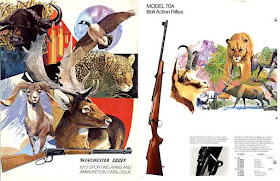The Winchester model 77 was a semi-automatic rifle chambered in .22 Long Rifle.
The rifle was produced at the old Winchester plant in New Haven, CT from 1955 through 1962. The arm came in two magazine versions, either tube or box and two trim versions, standard and deluxe.
The deluxe model featured hand checkering, sling swivels studs, grip cap and white line spacers. The deluxe stock also had a more defined wrist with flutes cut in at the front of the comb.
Original 1955 advertisement
The introductory price was $29.95 for the box magazine model and $34.95 for the tube fed version. Those prices increased to $46.95 and $53.95 respectively by 1960. There was of course a premium for the deluxe version.
The guns made the first year had the serial number placed at the front of the receiver on the left side. In late 1955/early 1956 the serial number was moved to the rear, left of the receiver. Sometime later (opinions vary and there are no accurate records) the serial number was removed altogether. This was before serial numbers were required (due to passage of the 1968 Gun Control Act).
The receiver was semi-tubular steel and gracefully disappeared into the stock at the wrist. It looks a lot like this gun could have inspired the design of the Marlin model 99 & 60 which came along in 1959 and 1960.
a comparison of the model 77 (top) and Marlin model 99 (bottom)
The receiver had cut in grooves (3/8") for the mounting of rimfire scopes
The stocks were made of straight grain walnut, the guns were all steel with the exception of the trigger guard, which was made of nylon.
The charging handle was located on the left side, forward of the receiver.
Specifications
Caliber: .22 Long Rifle
Action: Semi-Automatic
Barrel length: 22"
Overall length: 40"
LOP: 13.5"
Weight: 5lbs 9oz.
Capacity: 8 round box, 15 round tube
Years made: 1955-1963
There is a lot of speculation as to why Winchester quit producing the model 77. Many claim that the introduction of the Remington Nylon 66 and the Marlin 99/60 put too much pressure on the market in terms of price.
In 1963 a Nylon 66 was selling for $54.95 and the Marlin for $53.95.
The year after the model 77 was retired, Ruger introduced their 10/22, forever changing the market for semi-auto .22 rifles.
If you would like to find the manufacturing date of your Winchester, you have few options. There are no factory records, no one knows exactly why or how the records were lost, but they no longer exist.
There is a website run by Winchester collector (see it here) , that can give you a pretty good guess on the build date.
1957 advertisement
1960 advertisement
1960 Winchester Catalog Page
My rifle was purchased last year as a project. It is a first year production (1955) with a five digit serial number, that is located on the left front of the receiver.
I plan on refinishing the wood, replacing the butt plate with a properly sized reproduction unit. Adding some period correct sling swivels and rebluing the metal pieces.
Here is what it looked like when I got it.
Special Thanks to the Rimfire Central Forum, links below
Winchester 77
Just Got a model 77
Winchester model 77























































